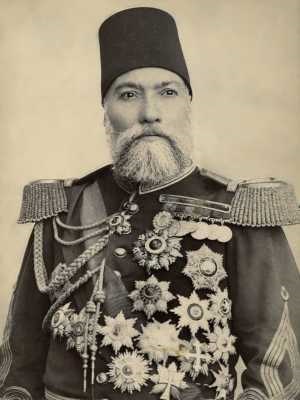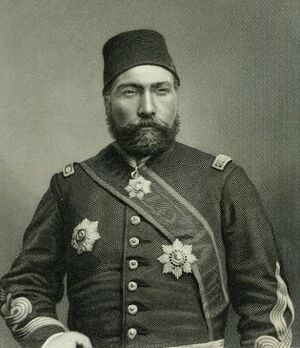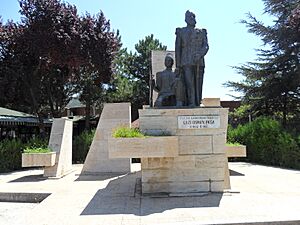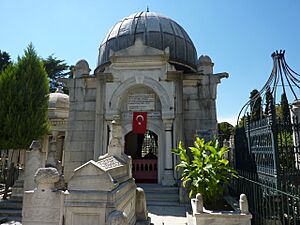Osman Nuri Pasha facts for kids
Quick facts for kids
Mushir
Gazi Osman Nuri
Pasha
|
|
|---|---|

Marshal Gazi Osman Pasha, 1895. Photograph by Abdullah Frères.
|
|
| Nickname(s) | Marshal of the Palace |
| Born | 1832 Tokat, Rûm Eyalet, Ottoman Empire |
| Died | 5 April 1900 (aged 67–68) Istanbul, Ottoman Empire |
| Buried |
Fatih Mosque, Istanbul, Turkey
(41°1′11″N 28°56′59″E / 41.01972°N 28.94972°E) |
| Allegiance | |
| Service/ |
|
| Rank | Field Marshal |
| Battles/wars | Cretan revolt (1866–1869) First Serbian–Ottoman War Second Serbian–Ottoman War Crimean War
|
| Awards | |
Osman Nuri Pasha (Ottoman Turkish: عثمان نوری پاشا; 1832 – 5 April 1900), also known as Gazi Osman Pasha, was a famous Ottoman military leader. He is remembered as one of the most respected Ottoman pashas (a high-ranking title). Many songs and places are named after him. He became famous for defending the town of Plevna in Bulgaria for five months. This happened in 1877 during the Russo-Turkish War. Even though his forces were outnumbered, he fought bravely before the city finally fell.
Contents
Early Life and Military Training
Osman Nuri was born in 1832 in the city of Tokat, which was part of the Ottoman Empire. His family was well-known. His father worked for the government and soon moved the family to Constantinople (now Istanbul), the capital city.
Osman went to the Kuleli Military High School. He then graduated from the Ottoman Military College in 1852. He became a lieutenant and joined the Cavalry (soldiers who fight on horseback). This was at the start of the Crimean War.
Osman Pasha's Military Career
Osman Nuri Pasha began his military career in the Cavalry during the Crimean War. His courage during this war earned him a promotion to first lieutenant. After the war ended, he joined the General Staff, which is like the main planning group for the army. A year later, he became a captain and was given the title of Bey, a respected rank.
Serving Across the Empire
In 1861, Osman was sent to Beirut Vilayet in Syria. There, he helped put down a rebellion. In 1866, he went to Crete, where a large revolt was happening. His good work there was noticed by a top commander, Serdar-ı Ekrem Omar Pasha. Osman was promoted to colonel and received an important award called the Order of the Medjidie.
His next assignment was in Yemen in 1868. There, he was promoted to major-general and given the title of Pasha. However, he became ill and had to return to Constantinople in 1871. After a few months of rest, he was put in charge of the Third Army in Rumelia. In 1873, he became a lieutenant general. He then served in different places like Scutari and Bosnia.
Wars and the Road to Plevna
In 1876, the Principality of Serbia declared its independence and started a war with the Ottoman Empire. Osman Pasha, who was based in Vidin, led his army to victory against the Serbian forces.
However, in April 1877, Russia declared war on the Ottomans. Russian troops crossed the Danube into Bulgaria. Osman Pasha, with about 15,000 soldiers and 174 cannons, was ordered to protect the important fortress of Nikopol. But before he could get there, the city fell to the Russians on July 16 after the Battle of Nikopol.
Osman knew that the Russians would try to cross the Balkans next. This was the last big natural barrier before Constantinople. But the Russians couldn't risk moving forward if a strong enemy army was behind them. So, Osman moved his army about 20 miles south of Nikopol to Plevna. Plevna was a small town surrounded by hills and deep valleys. The first Russian attack on July 20 was easily pushed back.
The Heroic Defense of Plevna
After the first attack, Osman Pasha quickly prepared for the next one. He used the natural hills and valleys to his advantage. He built a strong network of forts, trenches, and small forts called redoubts. This allowed his soldiers to use their better weapons very effectively. His troops had modern Krupp artillery, long-range Peabody-Martini rifles, and Winchester repeating rifles. These weapons were much better than what the Russians had. He also received 5,000 more soldiers as backup.
First and Second Attacks
On July 30, the Russians attacked again. They lost over 7,000 soldiers, which was almost a third of their attacking force. The Russian army was now very weak and discouraged. At this point, Osman Pasha could have launched a counterattack. This might have put the entire Russian army south of the Danube River in danger. But he chose to follow his orders and continued to defend Plevna.
The Russians quickly recovered. Grand Duke Nicholas, the Russian commander, asked for help from Prince Carol I of the newly independent Principality of Romania. The Romanian Army sent 40,000 soldiers with 112 modern Krupp cannons. Prince Carol I was made the commander of the combined Russian-Romanian forces around Plevna. By now, the Allied Army had 80,000 soldiers, while Osman Pasha had about 40,000.
Third Attack and Siege
Against Prince Carol's advice, the Allies launched another big attack on Plevna on September 11. After two days of fighting, the Allies managed to capture a few redoubts. However, Osman Pasha's forces recaptured almost all of them. Only one, Grivitza 1, was taken by the Romanian soldiers. The Allies had suffered too many losses. So, they decided to start a siege and completely surround Plevna.
Osman Pasha asked for permission to leave Plevna before his army was fully trapped, but his request was denied. By December, his army was running low on food and ammunition. His soldiers were suffering from hunger, cold, and sickness. Osman knew he couldn't hold out through the winter, and no help was coming from outside.
The Final Breakout Attempt
Instead of surrendering, Osman Pasha decided to try and break through the siege lines. On December 9, the Ottoman army attacked a part of the Russian line. They almost broke through. But the Russians fought back hard, closing the gap after intense hand-to-hand combat. The Ottomans were forced back.
However, Osman's army could not return to Plevna. During the fight, the Romanian army had captured the defenses behind them. This made it impossible to go back to their forts. Also, Osman was wounded in the leg by a bullet. His troops panicked, thinking he had died. With his army caught between the Allied forces, Osman Pasha had no choice but to surrender to Mihail Cerchez.
Return and Legacy

In 1878, after the Treaty of Berlin was signed, Osman Pasha returned from being held by the Russians. He received a hero's welcome in Constantinople. He was given the title of Gazi (meaning "victorious warrior") for his bravery. He was also promoted to the highest military rank, Field Marshal.
The Sultan made him Marshal of the Palace. The Ottoman military anthem, still used today in Turkey, called Plevna March, was composed to honor his achievements in Plevna. He served as War Minister four times.
Osman Nuri Pasha died in Constantinople on April 5, 1900. He was buried next to the Mosque of Fatih Sultan Mehmet, as he had wished. The Sultan himself ordered his tomb to be built. Osman Pasha is still honored in Turkey today as a brave hero who showed amazing determination against impossible odds. A Turkish flag is often seen on his tomb.
Images for kids







